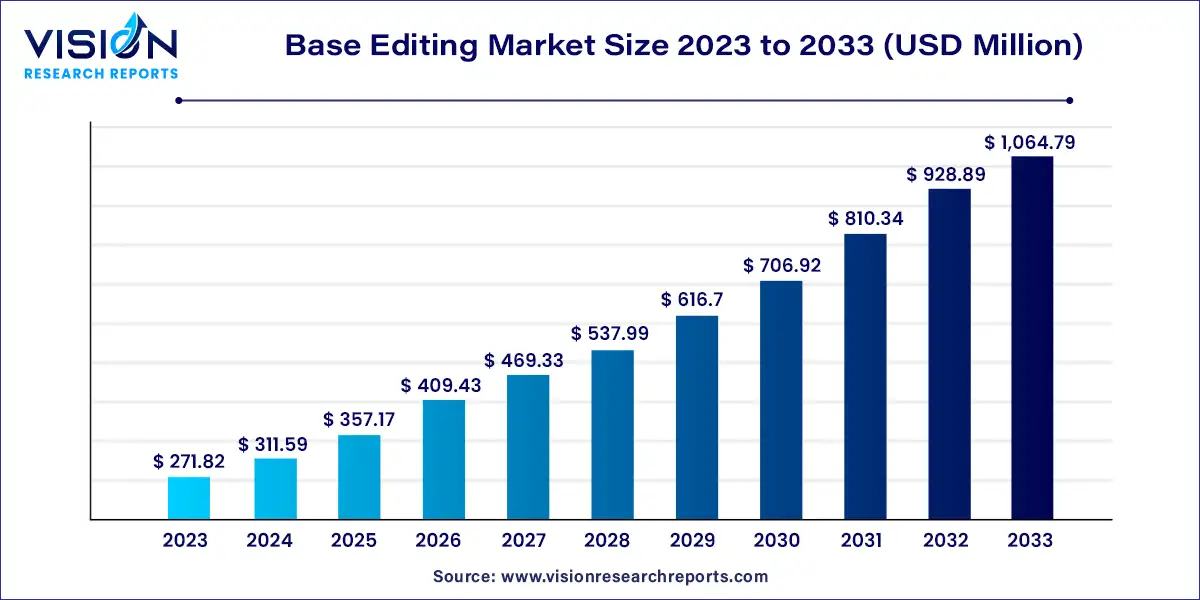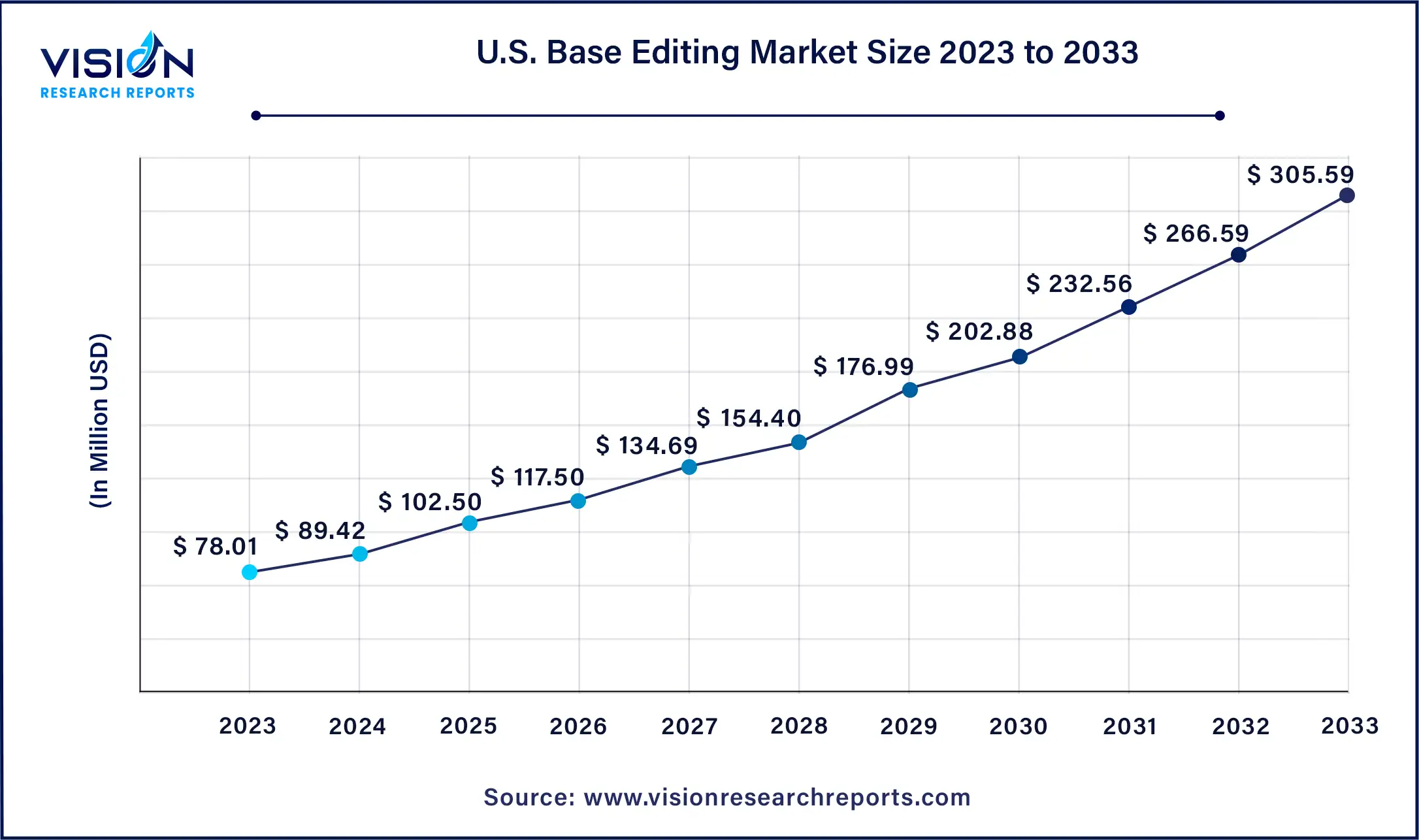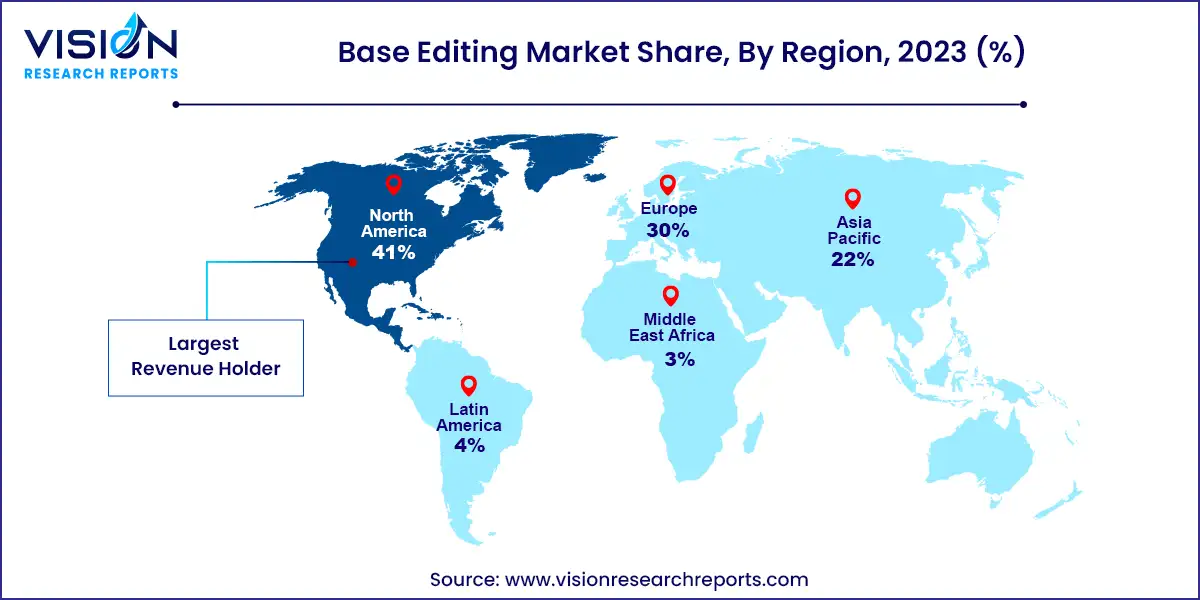The global base editing market size was estimated at around USD 271.82 million in 2023 and it is projected to hit around USD 1,064.79 million by 2033, growing at a CAGR of 14.64% from 2024 to 2033. The base editing market is emerging rapidly, driven by technological advancements, increasing investments in biotechnology, and growing interest in precision medicine.

The base editing market is experiencing robust growth due to the continuous technological advancements in gene-editing techniques, which have significantly improved the precision, efficiency, and safety of base editing processes. Additionally, the rising prevalence of genetic disorders has created a pressing demand for innovative treatment options, propelling the adoption of base editing technologies. Furthermore, substantial investments and funding from government bodies, private investors, and biotech companies are fueling research and development activities, leading to new discoveries and applications. The growing emphasis on precision medicine, which aims to provide tailored treatments based on individual genetic profiles, is also accelerating market expansion. This focus on personalized healthcare solutions underscores the potential of base editing to revolutionize medical treatments and drive market growth.
The U.S. base editing market size was estimated at USD 78.01 million in 2023 and is expected to surpass around USD 305.59 million by 2033, poised to grow at a CAGR of 14.5% from 2024 to 2033.

The U.S. base editing market is projected to grow due to increasing government funding, a focus on genomic studies, and the rising prevalence of diseases. Research in drug discovery, personalized medicine, and targeted therapies is anticipated to further fuel market growth.

North America led the market with a 41% share in 2023, driven by advanced healthcare infrastructure, the strong presence of leading biotechnology firms, and substantial funding for genomic research. Increasing healthcare expenditure, awareness of genetic therapies, and supportive government initiatives are expected to boost the market.
| Attribute | North America |
| Market Value | USD 111.44 Million |
| Growth Rate | 14.5% CAGR |
| Projected Value | USD 436.56 Million |
The Asia Pacific base editing market is expected to grow rapidly, with a projected CAGR of 15.62% from 2024 to 2033. This growth is attributed to the rising incidence of chronic diseases, increasing government support for genomics research, and a growing preference for gene editing technologies in agriculture and therapeutics. In China, the base editing market is set to expand, with researchers applying the technology across various fields, from agriculture to medicine. For instance, in May 2024, China approved the production and consumption of gene-edited wheat, following maize and soybean. Such regulatory approvals expedite the use of gene editing technology, boosting market growth
The base editing market faces several key challenges that could impact its growth and development. Ethical and regulatory concerns are at the forefront, as gene-editing technologies raise significant moral questions regarding the potential for unintended consequences and long-term effects on the human genome. Regulatory bodies are still in the process of establishing comprehensive guidelines, which can delay the approval and commercialization of base editing therapies.
Technical limitations also present a major challenge, including issues related to the delivery efficiency of base editing tools and the precision of targeting specific DNA bases without causing off-target effects. Additionally, the high costs associated with research, development, and implementation of base editing technologies may limit their accessibility, particularly in developing regions. Addressing these challenges will be crucial for the base editing market to achieve its full potential and deliver on its promise of revolutionizing genetic medicine and biotechnology.
In 2023, the product segment led the market in revenue and is expected to grow at a notable CAGR of 15.33%. This segment includes categories such as platforms, kits & reagents, plasmids, and base editing libraries. Base editing platforms are crucial tools in genetic engineering, enabling precise DNA modifications. These platforms typically comprise a base editor enzyme, guide RNA (gRNA), and a delivery system, allowing for targeted nucleotide conversion without double-strand breaks. This method offers greater precision than traditional gene editing techniques like CRISPR-Cas9, minimizing off-target effects and enhancing efficiency. Kits and reagents tailored for base editing provide researchers with essential components, such as Cas9 proteins, gRNAs, and deaminase enzymes, ensuring accurate and safe gene modification.
The services segment includes gRNA design and cell line engineering, allowing customers to generate point mutations in DNA using CRISPR-based technologies. Designing guide RNAs (gRNAs) is a critical step in the base editing process, directing the modified Cas9 enzyme to specific genomic locations. Advances in software tools have significantly simplified the design of gRNAs for single or multiple targets across various organisms and plants, enhancing the precision of CRISPR-based editing.
The drug discovery & development segment dominated the market with a 53% share in 2023 and is projected to grow at a CAGR of 15.03% from 2024 to 2033. Base editing technology is highly valuable in drug discovery due to its ability to precisely modify single nucleotides in the genome, avoiding double-strand breaks. This precision is crucial for correcting genetic mutations linked to diseases targeted by pharmaceutical interventions. Base editing also enables the creation of disease models for drug screening and testing by introducing specific mutations into cellular or animal models. Additionally, base editing helps optimize drug targets and pathways by modifying gene expression or protein function, improving therapeutic outcomes.
In plant breeding, base editing has opened new opportunities for crop improvement. The technology has been used to edit the genomes of various plant species such as rice, maize, cotton, oilseed rape, tomato, strawberry, and watermelon. Furthermore, cytosine base editors (CBEs) have shown significant potential for precise genome editing in pigs, which are important for both agricultural and biomedical purposes. Base editing approaches can create genetic modifications leading to desirable traits or model human diseases in pigs.
In 2023, the DNA base editing segment held the largest market share and is expected to grow at a CAGR of 15.42% over the forecast period. DNA base editing allows for precise modification of single nucleotides within the DNA of living cells without causing double-strand breaks. This technique provides a more targeted approach than traditional gene-editing methods like CRISPR-Cas9. It allows researchers to study the impact of specific genetic mutations on cellular functions, create accurate disease models for studying pathogenesis and testing potential therapies, and correct genetic mutations underlying various diseases.
RNA base editing is an emerging technology enabling precise modifications to RNA molecules. This reversible and temporary method corrects disease-causing mutations without the risk of permanent genotoxic effects. Recently, RNA base editing has gained attention for its potential applications in treating genetic disorders and advancing therapeutic interventions. As research progresses, the potential for using RNA base editing in clinical settings to treat various genetic disorders remains promising.
In 2023, pharmaceutical and biotechnology companies dominated the market with a revenue share of 52%. These companies are exploring base editing as a tool to develop novel therapies, addressing various genetic disorders, and advancing precision medicine. They are heavily investing in research and development to utilize advanced gene editing tools for creating new treatments. By combining precise base editing with CRISPR's gene-targeting capabilities, these companies aim to develop curative therapies and enhance patient outcomes.
The academic and research institutes segment is expected to grow at the highest CAGR over the forecast period. Base editing technology has gained significant traction in academic and research settings due to its precise genome editing capabilities. Institutions use base editing tools like CRISPR for a wide range of applications, including functional genomics, disease research, crop improvement, and model organism studies. Extensive ongoing research in drug discovery and therapeutics further contributes to market growth. For example, research published in Science Magazine in March 2023 demonstrated promising results in alleviating spinal muscular atrophy (SMA) using base editing technology in mouse models.
By Products & Services
By Application
By Type
By End-use
By Region
Chapter 1. Introduction
1.1. Research Objective
1.2. Scope of the Study
1.3. Definition
Chapter 2. Research Methodology
2.1. Research Approach
2.2. Data Sources
2.3. Assumptions & Limitations
Chapter 3. Executive Summary
3.1. Market Snapshot
Chapter 4. Market Variables and Scope
4.1. Introduction
4.2. Market Classification and Scope
4.3. Industry Value Chain Analysis
4.3.1. Raw Material Procurement Analysis
4.3.2. Sales and Distribution Channel Analysis
4.3.3. Downstream Buyer Analysis
Chapter 5. COVID 19 Impact on Base Editing Market
5.1. COVID-19 Landscape: Base Editing Industry Impact
5.2. COVID 19 - Impact Assessment for the Industry
5.3. COVID 19 Impact: Global Major Government Policy
5.4. Market Trends and Opportunities in the COVID-19 Landscape
Chapter 6. Market Dynamics Analysis and Trends
6.1. Market Dynamics
6.1.1. Market Drivers
6.1.2. Market Restraints
6.1.3. Market Opportunities
6.2. Porter’s Five Forces Analysis
6.2.1. Bargaining power of suppliers
6.2.2. Bargaining power of buyers
6.2.3. Threat of substitute
6.2.4. Threat of new entrants
6.2.5. Degree of competition
Chapter 7. Competitive Landscape
7.1.1. Company Market Share/Positioning Analysis
7.1.2. Key Strategies Adopted by Players
7.1.3. Vendor Landscape
7.1.3.1. List of Suppliers
7.1.3.2. List of Buyers
Chapter 8. Global Base Editing Market, By Products & Services
8.1. Base Editing Market, by Products & Services, 2024-2033
8.1.1. Product
8.1.1.1. Market Revenue and Forecast (2021-2033)
8.1.2. Services
8.1.2.1. Market Revenue and Forecast (2021-2033)
Chapter 9. Global Base Editing Market, By Application
9.1. Base Editing Market, by Application, 2024-2033
9.1.1. Drug Discovery & Development
9.1.1.1. Market Revenue and Forecast (2021-2033)
9.1.2. Agriculture
9.1.2.1. Market Revenue and Forecast (2021-2033)
9.1.3. Veterinary
9.1.3.1. Market Revenue and Forecast (2021-2033)
Chapter 10. Global Base Editing Market, By Type
10.1. Base Editing Market, by Type, 2024-2033
10.1.1. DNA Base Editing
10.1.1.1. Market Revenue and Forecast (2021-2033)
10.1.2. RNA Base Editing
10.1.2.1. Market Revenue and Forecast (2021-2033)
Chapter 11. Global Base Editing Market, By End-use
11.1. Base Editing Market, by End-use, 2024-2033
11.1.1. Academic & Research Institutes
11.1.1.1. Market Revenue and Forecast (2021-2033)
11.1.2. Contract Research Organizations
11.1.2.1. Market Revenue and Forecast (2021-2033)
11.1.3. Pharmaceutical & Biotechnology Companies
11.1.3.1. Market Revenue and Forecast (2021-2033)
Chapter 12. Global Base Editing Market, Regional Estimates and Trend Forecast
12.1. North America
12.1.1. Market Revenue and Forecast, by Products & Services (2021-2033)
12.1.2. Market Revenue and Forecast, by Application (2021-2033)
12.1.3. Market Revenue and Forecast, by Type (2021-2033)
12.1.4. Market Revenue and Forecast, by End-use (2021-2033)
12.1.5. U.S.
12.1.5.1. Market Revenue and Forecast, by Products & Services (2021-2033)
12.1.5.2. Market Revenue and Forecast, by Application (2021-2033)
12.1.5.3. Market Revenue and Forecast, by Type (2021-2033)
12.1.5.4. Market Revenue and Forecast, by End-use (2021-2033)
12.1.6. Rest of North America
12.1.6.1. Market Revenue and Forecast, by Products & Services (2021-2033)
12.1.6.2. Market Revenue and Forecast, by Application (2021-2033)
12.1.6.3. Market Revenue and Forecast, by Type (2021-2033)
12.1.6.4. Market Revenue and Forecast, by End-use (2021-2033)
12.2. Europe
12.2.1. Market Revenue and Forecast, by Products & Services (2021-2033)
12.2.2. Market Revenue and Forecast, by Application (2021-2033)
12.2.3. Market Revenue and Forecast, by Type (2021-2033)
12.2.4. Market Revenue and Forecast, by End-use (2021-2033)
12.2.5. UK
12.2.5.1. Market Revenue and Forecast, by Products & Services (2021-2033)
12.2.5.2. Market Revenue and Forecast, by Application (2021-2033)
12.2.5.3. Market Revenue and Forecast, by Type (2021-2033)
12.2.5.4. Market Revenue and Forecast, by End-use (2021-2033)
12.2.6. Germany
12.2.6.1. Market Revenue and Forecast, by Products & Services (2021-2033)
12.2.6.2. Market Revenue and Forecast, by Application (2021-2033)
12.2.6.3. Market Revenue and Forecast, by Type (2021-2033)
12.2.6.4. Market Revenue and Forecast, by End-use (2021-2033)
12.2.7. France
12.2.7.1. Market Revenue and Forecast, by Products & Services (2021-2033)
12.2.7.2. Market Revenue and Forecast, by Application (2021-2033)
12.2.7.3. Market Revenue and Forecast, by Type (2021-2033)
12.2.7.4. Market Revenue and Forecast, by End-use (2021-2033)
12.2.8. Rest of Europe
12.2.8.1. Market Revenue and Forecast, by Products & Services (2021-2033)
12.2.8.2. Market Revenue and Forecast, by Application (2021-2033)
12.2.8.3. Market Revenue and Forecast, by Type (2021-2033)
12.2.8.4. Market Revenue and Forecast, by End-use (2021-2033)
12.3. APAC
12.3.1. Market Revenue and Forecast, by Products & Services (2021-2033)
12.3.2. Market Revenue and Forecast, by Application (2021-2033)
12.3.3. Market Revenue and Forecast, by Type (2021-2033)
12.3.4. Market Revenue and Forecast, by End-use (2021-2033)
12.3.5. India
12.3.5.1. Market Revenue and Forecast, by Products & Services (2021-2033)
12.3.5.2. Market Revenue and Forecast, by Application (2021-2033)
12.3.5.3. Market Revenue and Forecast, by Type (2021-2033)
12.3.5.4. Market Revenue and Forecast, by End-use (2021-2033)
12.3.6. China
12.3.6.1. Market Revenue and Forecast, by Products & Services (2021-2033)
12.3.6.2. Market Revenue and Forecast, by Application (2021-2033)
12.3.6.3. Market Revenue and Forecast, by Type (2021-2033)
12.3.6.4. Market Revenue and Forecast, by End-use (2021-2033)
12.3.7. Japan
12.3.7.1. Market Revenue and Forecast, by Products & Services (2021-2033)
12.3.7.2. Market Revenue and Forecast, by Application (2021-2033)
12.3.7.3. Market Revenue and Forecast, by Type (2021-2033)
12.3.7.4. Market Revenue and Forecast, by End-use (2021-2033)
12.3.8. Rest of APAC
12.3.8.1. Market Revenue and Forecast, by Products & Services (2021-2033)
12.3.8.2. Market Revenue and Forecast, by Application (2021-2033)
12.3.8.3. Market Revenue and Forecast, by Type (2021-2033)
12.3.8.4. Market Revenue and Forecast, by End-use (2021-2033)
12.4. MEA
12.4.1. Market Revenue and Forecast, by Products & Services (2021-2033)
12.4.2. Market Revenue and Forecast, by Application (2021-2033)
12.4.3. Market Revenue and Forecast, by Type (2021-2033)
12.4.4. Market Revenue and Forecast, by End-use (2021-2033)
12.4.5. GCC
12.4.5.1. Market Revenue and Forecast, by Products & Services (2021-2033)
12.4.5.2. Market Revenue and Forecast, by Application (2021-2033)
12.4.5.3. Market Revenue and Forecast, by Type (2021-2033)
12.4.5.4. Market Revenue and Forecast, by End-use (2021-2033)
12.4.6. North Africa
12.4.6.1. Market Revenue and Forecast, by Products & Services (2021-2033)
12.4.6.2. Market Revenue and Forecast, by Application (2021-2033)
12.4.6.3. Market Revenue and Forecast, by Type (2021-2033)
12.4.6.4. Market Revenue and Forecast, by End-use (2021-2033)
12.4.7. South Africa
12.4.7.1. Market Revenue and Forecast, by Products & Services (2021-2033)
12.4.7.2. Market Revenue and Forecast, by Application (2021-2033)
12.4.7.3. Market Revenue and Forecast, by Type (2021-2033)
12.4.7.4. Market Revenue and Forecast, by End-use (2021-2033)
12.4.8. Rest of MEA
12.4.8.1. Market Revenue and Forecast, by Products & Services (2021-2033)
12.4.8.2. Market Revenue and Forecast, by Application (2021-2033)
12.4.8.3. Market Revenue and Forecast, by Type (2021-2033)
12.4.8.4. Market Revenue and Forecast, by End-use (2021-2033)
12.5. Latin America
12.5.1. Market Revenue and Forecast, by Products & Services (2021-2033)
12.5.2. Market Revenue and Forecast, by Application (2021-2033)
12.5.3. Market Revenue and Forecast, by Type (2021-2033)
12.5.4. Market Revenue and Forecast, by End-use (2021-2033)
12.5.5. Brazil
12.5.5.1. Market Revenue and Forecast, by Products & Services (2021-2033)
12.5.5.2. Market Revenue and Forecast, by Application (2021-2033)
12.5.5.3. Market Revenue and Forecast, by Type (2021-2033)
12.5.5.4. Market Revenue and Forecast, by End-use (2021-2033)
12.5.6. Rest of LATAM
12.5.6.1. Market Revenue and Forecast, by Products & Services (2021-2033)
12.5.6.2. Market Revenue and Forecast, by Application (2021-2033)
12.5.6.3. Market Revenue and Forecast, by Type (2021-2033)
12.5.6.4. Market Revenue and Forecast, by End-use (2021-2033)
Chapter 13. Company Profiles
13.1. ElevateBio
13.1.1. Company Overview
13.1.2. Product Offerings
13.1.3. Financial Performance
13.1.4. Recent Initiatives
13.2. Merck KGaA
13.2.1. Company Overview
13.2.2. Product Offerings
13.2.3. Financial Performance
13.2.4. Recent Initiatives
13.3. Revvity
13.3.1. Company Overview
13.3.2. Product Offerings
13.3.3. Financial Performance
13.3.4. Recent Initiatives
13.4. Maravai LifeSciences
13.4.1. Company Overview
13.4.2. Product Offerings
13.4.3. Financial Performance
13.4.4. Recent Initiatives
13.5. GenScript
13.5.1. Company Overview
13.5.2. Product Offerings
13.5.3. Financial Performance
13.5.4. Recent Initiatives
13.6. Beam Therapeutics
13.6.1. Company Overview
13.6.2. Product Offerings
13.6.3. Financial Performance
13.6.4. Recent Initiatives
13.7. Intellia Therapeutics, Inc.
13.7.1. Company Overview
13.7.2. Product Offerings
13.7.3. Financial Performance
13.7.4. Recent Initiatives
13.8. Cellectis
13.8.1. Company Overview
13.8.2. Product Offerings
13.8.3. Financial Performance
13.8.4. Recent Initiatives
13.9. ElevateBio
13.9.1. Company Overview
13.9.2. Product Offerings
13.9.3. Financial Performance
13.9.4. Recent Initiatives
13.10. Creative Biogene
13.10.1. Company Overview
13.10.2. Product Offerings
13.10.3. Financial Performance
13.10.4. Recent Initiatives
Chapter 14. Research Methodology
14.1. Primary Research
14.2. Secondary Research
14.3. Assumptions
Chapter 15. Appendix
15.1. About Us
15.2. Glossary of Terms
 Cross-segment Market Size and Analysis for
Mentioned Segments
Cross-segment Market Size and Analysis for
Mentioned Segments
 Additional Company Profiles (Upto 5 With No Cost)
Additional Company Profiles (Upto 5 With No Cost)
 Additional Countries (Apart From Mentioned Countries)
Additional Countries (Apart From Mentioned Countries)
 Country/Region-specific Report
Country/Region-specific Report
 Go To Market Strategy
Go To Market Strategy
 Region Specific Market Dynamics
Region Specific Market Dynamics Region Level Market Share
Region Level Market Share Import Export Analysis
Import Export Analysis Production Analysis
Production Analysis Others
Others